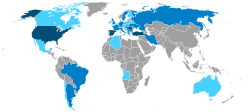
History provides many examples of notable diasporas. The Eurominority.eu map (the European Union) Peoples of the World includes some diasporas and underrepresented/stateless ethnic groups. [1]
Contents
Note: the list below is not definitive and includes groups that have not been given significant historical attention. Whether the migration of some of the groups listed fulfils the conditions required to be considered a diaspora may be open for debate.























































































